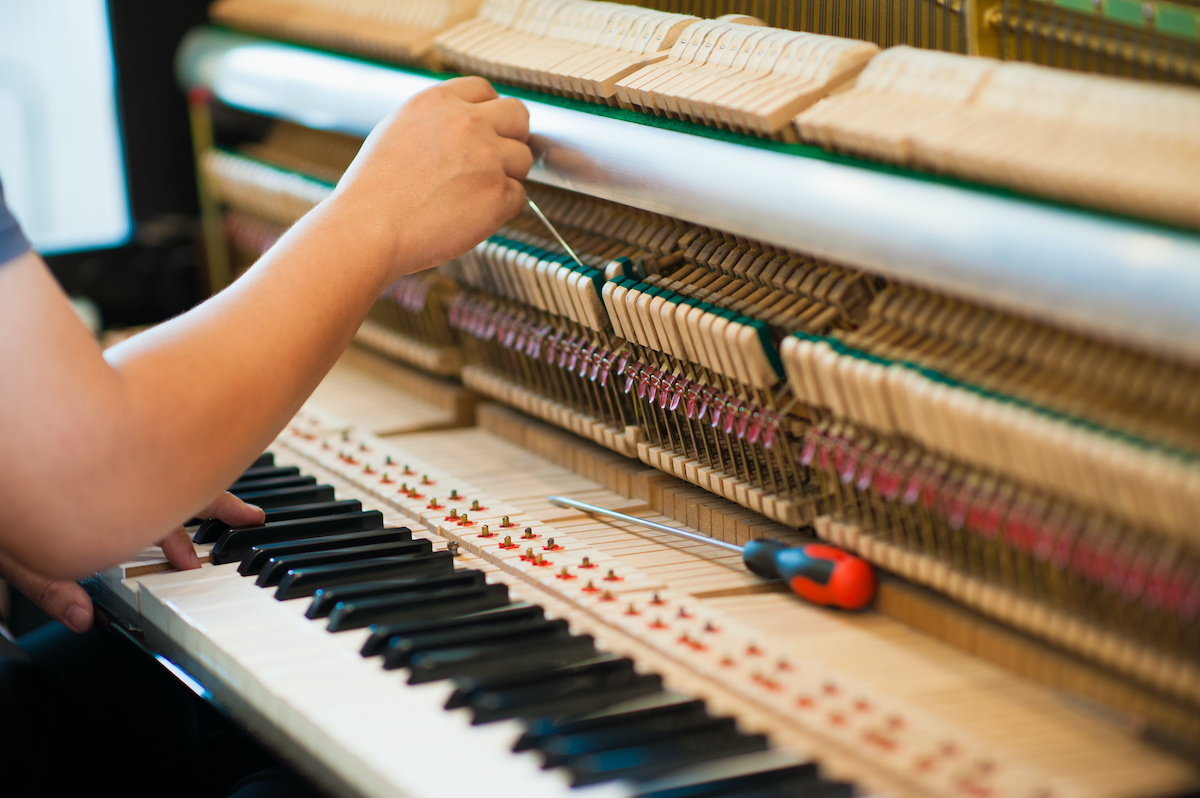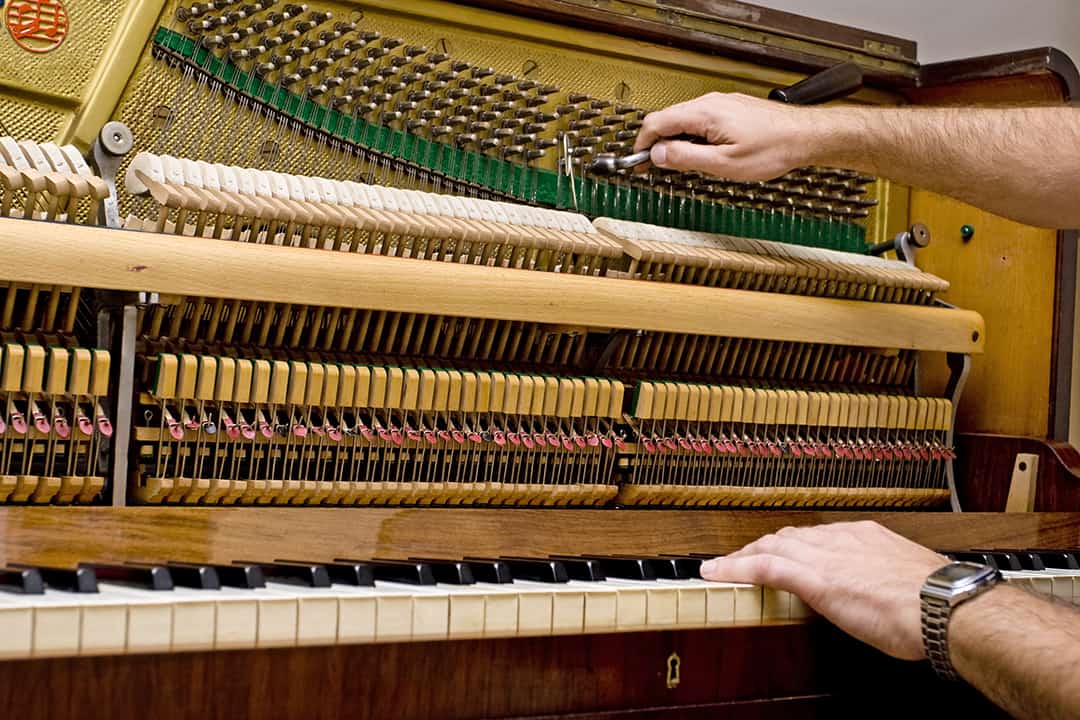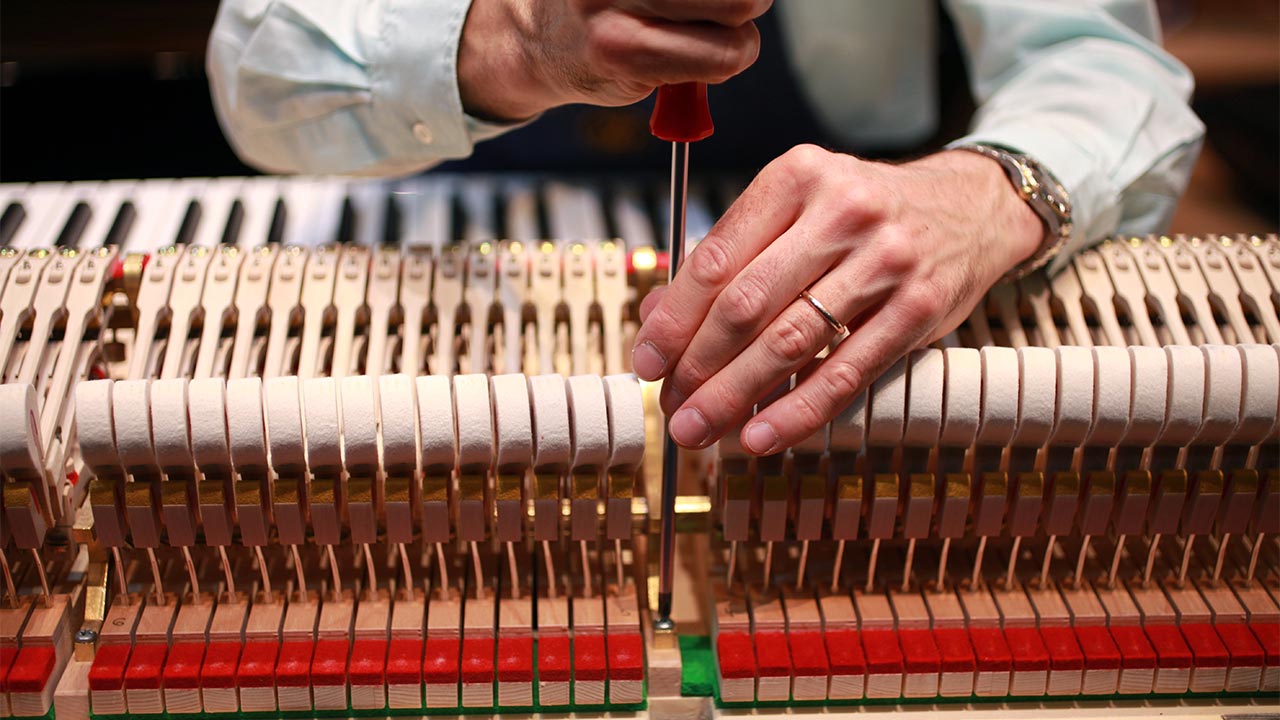Pianos are tuned by adjusting the tension of each string to achieve the correct pitch. This is done using a tuning lever or hammer.
Tuning a piano is a delicate process that requires a keen ear and experienced touch. A piano tuner will typically start by ensuring the A440 note, or A above middle C, is tuned to the standard pitch of 440Hz, which serves as the reference point for tuning all other notes.
With precision, the tuner then methodically adjusts the strings throughout the piano, making sure each string resonates at the perfect frequency. This task combines art and science, as the tuner balances physical adjustments with auditory feedback. Regular tuning is essential for maintaining the rich, harmonious sound of a piano, and it’s usually recommended to have a piano professionally tuned at least once a year. Skilled technicians not only tune the strings but also check the overall condition of the piano, making any necessary repairs or adjustments to ensure the instrument’s longevity and performance.

Credit: www.masterclass.com
The Art Of Piano Tuning
Welcome to the intriguing world of the Art of Piano Tuning. A finely tuned piano offers a symphony of harmonious notes, enriching musical performances. Mastering the tuning of these majestic instruments requires precision, a keen ear, and a blend of science and artistry.
Origins Of Piano Tuning
Long before modern technology, piano tuning was already an art form. It started with early keyboard instruments. Craftsmen would painstakingly adjust each string by ear. This practice has evolved, shaping the soundscapes of countless concert halls and living rooms alike.
Tools Of The Trade
Today’s piano tuners use a selection of specialized tools to achieve harmonic perfection.
- Tuning Lever: Also known as a tuning hammer, this tool tightens or loosens the piano’s strings to the correct pitch.
- Electronic Tuner: Provides a visual guide for precise pitch adjustment.
- Mutes: Small felt or rubber tools that isolate strings for individual tuning.
- Tuning Fork: Helps the tuner find the standard pitch (usually A440).
With these tools, tuners ensure every note from the piano rings clear and true.
Anatomy Of A Piano
The piano, a complex and beautiful instrument, captivates with its melodic potency. To understand the art of piano tuning, diving into its anatomy is essential. The inner workings involve a delicate balance of components, each playing a crucial role in producing the instrument’s rich sound. Let’s explore these fundamental elements.
Strings And Pins
Pianos create music through strings stretched over a frame. Each note corresponds to a specific string, or sometimes, a group of strings. These strings attach to pins, tightly wound on a pinblock. Tuning involves turning these pins with a special tool. This action either tightens or loosens the strings, adjusting the pitch. Keys pressed result in hammers striking these strings. This creates the piano’s signature resonances.
- Tuning pins: Adjust the tension of the strings.
- Strings: Produce sound with their vibrations.
- Pinblock: Holds the tuning pins in place.
- Hammer action: Hammers strike the strings when keys are pressed.
The Soundboard’s Role
The soundboard serves as the heart of a piano’s voice. Made from carefully selected wood, it amplifies the vibrations of the strings. Without it, the strings alone would emit only a faint sound. The soundboard resonates, projecting the tone through the piano body and out to the listeners. This wooden diaphragm is not only foundational to volume but also to the quality of the sound. Its care is paramount in piano maintenance and for optimal tuning.
| Component | Function |
|---|---|
| Strings | Vibrate to create sound |
| Soundboard | Amplifies vibrations |
Preparing For A Tuning Session
Welcome to the world of piano maintenance, where precision meets artistry. Tuning a piano is crucial for its performance. Before a professional tuner dives into the intricate process, certain steps ensure a successful tuning session. Let’s explore these under our key subheadings.
Initial Assessment
A thorough initial assessment sets the stage for the tuning process. The tuner will inspect the piano for any visible issues. This includes checking the:
- Overall condition of the piano’s interior and exterior
- Integrity of the strings and soundboard
- Functionality of the keys and hammers
Detecting any irregularities early can aid in the smooth progression of tuning. Mechanical concerns must be addressed prior to beginning.
Conditioning The Environment
The environment plays a key role in the piano’s tuning stability. Regulating the room’s temperature and humidity is essential. This preparation involves:
| Action | Reason |
|---|---|
| Maintaining a steady temperature | Prevents string tension fluctuation |
| Controlling humidity levels | Ensures consistent soundboard response |
Tuners might ask for these conditions to be set hours before the session to stabilize the piano. Tuning accuracy improves in a well-conditioned environment.
Tuning Techniques
Have you ever wondered how pianos create such harmonious melodies? It all starts with an essential process called tuning. In this section, we’ll delve into the art and precision of piano tuning, exploring the techniques that ensure your piano sounds pitch-perfect. These aren’t just any methods; they are time-honored practices that require a keen ear and a steady hand.
Setting The Temperament
Setting the temperament is the crucial first step in piano tuning. It lays the foundation for a well-tuned instrument. Technicians focus on a single octave in the middle of the piano. They fine-tune these notes until they reach a perfect harmony. This sets a pattern for tuning the rest of the keys. A device called a tuning lever, also known as a hammer, is the main tool used. The tuner adjusts each string’s tension, listening carefully to achieve the right sound.
Octave Tuning Methods
Once the temperament octave is set, the tuner expands their focus to the rest of the piano. Using various octave tuning methods ensures consistency. There are two primary methods: ‘octave stretching’ and ‘matching octaves’. In octave stretching, the tuner slightly adjusts the pitch higher in the upper octaves and lower in the lower ones. This accommodates the inherent inharmonicity of piano strings. Matching octaves is a method of aligning the pitch of notes exactly an octave apart. Tuners listen for beats, the fluctuation in sound when two notes are slightly off, and adjust until the beats disappear.
Maintaining Perfect Pitch
Pianos thrive on precision to produce the right sounds. As complex instruments, they require careful, regular maintenance to stay in perfect pitch. When a piano is in tune, each note resonates at a precise frequency, enabling musicians to deliver stellar performances. Let’s explore how regular tunings and environmental factors like temperature and humidity impact a piano’s pitch.
Regular Tuning Intervals
Consistent tunings are paramount for any piano. Over time, strings may stretch and contract, causing shifts in pitch. To prevent this, many experts recommend tuning at least twice a year. Depending on use, concert pianos may need tuning before each performance.
- Brief, semi-annual tunings sustain sound quality.
- Heavy use warrants more frequent attention.
Influence Of Humidity And Temperature
External factors like humidity and temperature play a large role in piano tuning. Wood and strings inside a piano expand and contract with these changes. This movement affects tension and pitch.
| Condition | Impact on Piano |
|---|---|
| High Humidity | Wood swells, pitch rises |
| Low Humidity | Wood contracts, pitch lowers |
| Rising Temperature | String tension drops, pitch lowers |
| Falling Temperature | String tension increases, pitch rises |
To mitigate these effects, owning a humidity control system is beneficial. Such a system maintains a consistent piano environment. This lessens the need for frequent tunings.

Credit: www.pianogallery.com
The Tuner’s Expertise
Imagine a piano, standing grand and majestic in a concert hall or cozy in a corner of a home. It’s a complex instrument with a delicate soul. Pianos rely heavily on their intricate web of strings and hammers. The mastery in bringing these elements into pitch-perfection lies in the tuner’s expertise.
Training And Experience
Piano tuning is not just about turning pegs and tightening strings. A tuner’s job requires an in-depth understanding of music theory, intricate mechanical knowledge, and a keen ear. Tuners undergo rigorous training, often through specialized courses or apprenticeships. The process includes learning about different piano models, understanding the delicate mechanics, and mastering tuning techniques.
Experienced tuners have honed their skills over years. They have encountered numerous piano types and situations. A tuner’s skill grows with each piano they finesse into harmony. They develop an intuition for the instrument, leading to quick diagnosis and precise adjustments.
The Tuner As A Musician’s Ally
Piano tuners work closely with musicians. They ensure that pianos are at their best for performances and practice. A well-tuned piano can inspire and elevate a musician’s art.
Tuners and musicians form a partnership rooted in mutual respect for music. Tuners often adapt their schedule to meet musicians’ needs before concerts or important events. They become integral to a musician’s success, providing counsel on the instrument’s care and maintenance.
Indeed, a piano tuner bridges the gap between a silent instrument and the mesmerizing melodies it can produce. This unsung expertise plays a critical role in the musical world.

Credit: www.bankrate.com
Can Serial Numbers Help in Determining the Tuning History of a Piano?
Pianos serial numbers explained can indeed help in determining the tuning history of a piano. By tracing the serial number, you can find out when the piano was last tuned and if it has been consistently maintained. This information is crucial for assessing the overall condition and value of the instrument.
Frequently Asked Questions For How Are Pianos Tuned
Can You Tune A Piano Yourself?
Yes, you can tune a piano yourself with the right tools and knowledge. Yet, it’s typically better to hire a professional for optimal sound quality.
Are Pianos Perfectly In Tune?
Pianos are not always perfectly in tune. Over time, environmental conditions and frequent use can cause tuning to drift. Regular tuning by a professional is necessary to maintain optimal sound quality.
Can A Piano Be Tuned After 20 Years?
Yes, a piano can be tuned after 20 years, but it may require multiple tuning sessions to regain optimal pitch stability.
How Long Can A Piano Go Without Being Tuned?
A piano typically needs tuning every 6 months, but can go up to a year without tuning if rarely used or in a stable environment.
Conclusion
Tuning a piano is both an art and a science. Mastering this task ensures each note resonates perfectly, providing a harmonious experience. Remember, regular tuning maintains a piano’s health and your musical enjoyment. Trust a professional tuner to keep your piano at its best and fill your space with beautiful melodies.
{ “@context”: “https://schema.org”, “@type”: “FAQPage”, “mainEntity”: [ { “@type”: “Question”, “name”: “Can you tune A piano yourself?”, “acceptedAnswer”: { “@type”: “Answer”, “text”: “Yes, you can tune a piano yourself with the right tools and knowledge. Yet, it’s typically better to hire a professional for optimal sound quality.” } } , { “@type”: “Question”, “name”: “Are pianos perfectly in tune?”, “acceptedAnswer”: { “@type”: “Answer”, “text”: “Pianos are not always perfectly in tune. Over time, environmental conditions and frequent use can cause tuning to drift. Regular tuning by a professional is necessary to maintain optimal sound quality.” } } , { “@type”: “Question”, “name”: “Can A piano be tuned after 20 years?”, “acceptedAnswer”: { “@type”: “Answer”, “text”: “Yes, a piano can be tuned after 20 years, but it may require multiple tuning sessions to regain optimal pitch stability.” } } , { “@type”: “Question”, “name”: “How long can A piano go without being tuned?”, “acceptedAnswer”: { “@type”: “Answer”, “text”: “A piano typically needs tuning every 6 months, but can go up to a year without tuning if rarely used or in a stable environment.” } } ] }